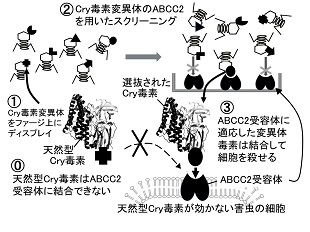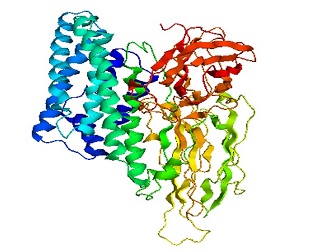BT菌の殺虫性タンパク質を人為的に進化させる方法で「タンパク質殺虫剤」というジャンルを生み出す

メンバー: 佐藤令一
分野: 境界農学、生物科学、環境保全学
所属: 農学研究院
キーワード: Cry毒素、殺虫性タンパク質、Bacillus thuringiensis、殺虫剤、組換え食品
ウェブサイト:
研究概要

環境と食糧の問題の同時解決を目指し、本研究ではまず、1)微生物が作り出した安心安全な殺虫性タンパク質(Cry毒素)の殺虫機構と、2)「Cry毒素とその受容体の双方の進化による多様化の実態」を学び、3)次にそれを基盤としてこれまで築いて来た進化分子工学の手法で任意の害虫に効く殺虫性タンパク質をオーダーメイドで生み出す方法の世界ではじめての完成を目指す。これは、日本では新ジャンル「タンパク質殺虫剤」の創生を、またアメリカやその他には、殺虫剤が不要でオーガニック食品とされ、数十億もの人間が食べ、19年の実績を持つ「害虫抵抗性組換え食品」のための「輸出用遺伝子資材創生」を意味する。
主要論文・参考事項
1. Haruka Endo, Yuki Kobayashi, Yasushi Hoshino, Shiho Tanaka, Shingo Kikuta,
Hiroko Tabunoki & Ryoichi Sato Affinity maturation of Cry1Aa toxin to the Bombyx mori cadherin-like receptor by directed evolution based on phage display and biopanning selections of domain II loop 2 mutant toxins. MicrobiologyOpen 3(4):568-77 (2014).
2. Fujii Y, Tanaka S, Otsuki M, Hoshino Y, Endo H, Sato R. Affinity Maturation of Cry1Aa Toxin to the Bombyx mori Cadherin-Like Receptor by Directed Evolution. Mol Biotechnol. 54(3):888-99 (2013).
3. Tanaka, S, Miyamoto, K, Noda, H, Jurat-Fuentes, JL, Yoshizawa, Y, Endo, H, Sato, R. The ATP-binding cassette transporter subfamily C member 2 in Bombyx mori larvae is a functional receptor for Cry toxins from Bacillus thuringiensis. The FEBS J. 280(8):1782-94 (2013).
4. Tanaka S, Yoshizawa Y and Sato R. Response of midgut epithelial cells to Cry1Aa is toxin-dependent and depends on the interplay between toxic action and the host apoptotic response The FEBS J 279(6), 1071-1079 (2012)
5. Yuki Fujii, Shiho Tanaka, Manami Otsuki, Yasushi Hoshino, Chinatsu Morimoto, Takuya Kotani, Yuko Harashima, Haruka Endo, Yasutaka Yoshizawa, and Ryoichi Sato Cry1Aa binding to the cadherin receptor does not require conserved amino acid sequences in the domain II loops Bioscience Reports 33(1):103-12 (2012)
6. Bacillus thuringiensis Cry Toxins Bound Specifically to Various Proteins via Domain III, Which Had a Galactose-Binding Domain-Like Fold. Kitami, M., Kadotani, T., Nakanishi, K., Atsumi, S., Higurashi, S., Ishizaka, T., Watanabe, A., Sato, R. Biosci Biotechnol Biochem, 査読有, 75, 305-312 (2011)
お問い合わせ先
東京農工大学・先端産学連携研究推進センター
urac[at]ml.tuat.ac.jp([at]を@に変換してください)
Studies on Bacillus thuringiensis insecticidal protein and its' mode of action to generate new category, “Proteinaceous Insecticide”.

Research members: Dr. Ryoichi Sato
Research fields: Boundary agriculture, Biological Science, Environmental conservation
Departments: Institute of Agriculture
Keywords: Cry toxin, insecticidal protein, Bacillus thuringiensis, insecticide, gene modified food
Web site:
Summary

We are attempting to solve the problems of pesticide which has influence to both environment and foods through the study of insecticidal protein from Bacillus thuringiensis. First, we will analyze mode of action of the insecticidal protein which is safe both to environment and human being. Second, we will make clear and recognize the actual result of evolution in both insecticidal protein and its receptors of insects. Third, we will try to construct insecticidal protein improving method using procedures of directed evolution which have been already constructed. From these, new category of insecticide, “proteinaceous insecticide” will be generated in Japan. Furthermore, insect pest resistant GM foods-generating transgenes for the exportation to foreign countries will be obtained.
Reference articles and patents
1. Haruka Endo, Yuki Kobayashi, Yasushi Hoshino, Shiho Tanaka, Shingo Kikuta,
Hiroko Tabunoki & Ryoichi Sato Affinity maturation of Cry1Aa toxin to the Bombyx mori cadherin-like receptor by directed evolution based on phage display and biopanning selections of domain II loop 2 mutant toxins. MicrobiologyOpen 3(4):568-77 (2014).
2. Fujii Y, Tanaka S, Otsuki M, Hoshino Y, Endo H, Sato R. Affinity Maturation of Cry1Aa Toxin to the Bombyx mori Cadherin-Like Receptor by Directed Evolution. Mol Biotechnol. 54(3):888-99 (2013).
3. Tanaka, S, Miyamoto, K, Noda, H, Jurat-Fuentes, JL, Yoshizawa, Y, Endo, H, Sato, R. The ATP-binding cassette transporter subfamily C member 2 in Bombyx mori larvae is a functional receptor for Cry toxins from Bacillus thuringiensis. The FEBS J. 280(8):1782-94 (2013).
4. Tanaka S, Yoshizawa Y and Sato R. Response of midgut epithelial cells to Cry1Aa is toxin-dependent and depends on the interplay between toxic action and the host apoptotic response The FEBS J 279(6), 1071-1079 (2012)
5. Yuki Fujii, Shiho Tanaka, Manami Otsuki, Yasushi Hoshino, Chinatsu Morimoto, Takuya Kotani, Yuko Harashima, Haruka Endo, Yasutaka Yoshizawa, and Ryoichi Sato Cry1Aa binding to the cadherin receptor does not require conserved amino acid sequences in the domain II loops Bioscience Reports 33(1):103-12 (2012)
6. Bacillus thuringiensis Cry Toxins Bound Specifically to Various Proteins via Domain III, Which Had a Galactose-Binding Domain-Like Fold. Kitami, M., Kadotani, T., Nakanishi, K., Atsumi, S., Higurashi, S., Ishizaka, T., Watanabe, A., Sato, R. Biosci Biotechnol Biochem, 査読有, 75, 305-312 (2011)
Contact
University Research Administration Center(URAC),
Tokyo University of Agriculture andTechnology
urac[at]ml.tuat.ac.jp
(Please replace [at] with @.)


